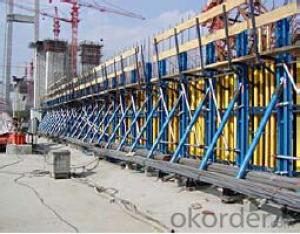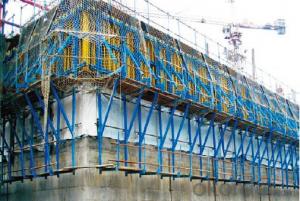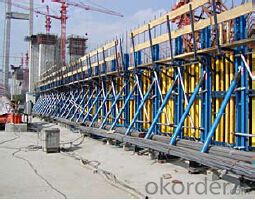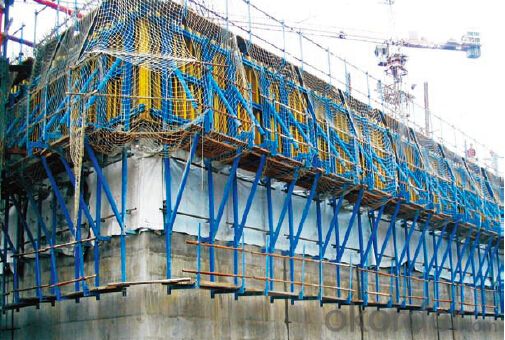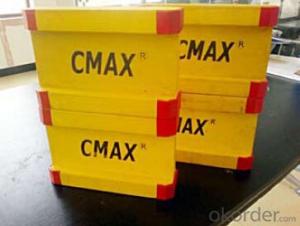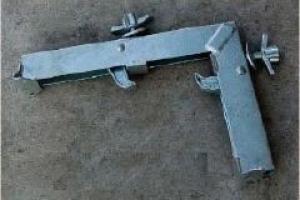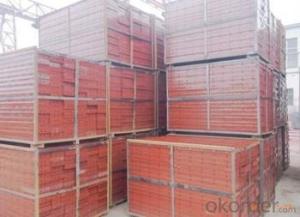Single-side climbing bracket for formwork and scaffolding systems
- Loading Port:
- Tianjin
- Payment Terms:
- TT OR LC
- Min Order Qty:
- 50 m²
- Supply Capability:
- 1000 m²/month
OKorder Service Pledge
OKorder Financial Service
You Might Also Like
Single-side Climbing Bracket SCB180:
With CNBM SCB 180 climbing systems, the loads from the fresh concrete pressure are
transferred through the brackets by means of V-strongbacks and compression braces into the
scaffold anchors.
Typical applications for the SCB 180 are dams, locks, cooling towers, pier heads, tunnels, and
bank vaults.
The formwork is simply tilted backwards when striking takes place. The 1.80 m wide bracket
requires only a minimum of space.
Characteristics:
◆ Economical and safe anchoring
The M30/D20 climbing cones have been designed especially for single-sided concreting using
SCB180 in dam construction, and to allow the transfer of high tensile and shear forces into the still
fresh, unreinforced concrete. Without wall-through tie-rods, finished concrete is perfect.
◆ Stable and cost-effective for high loads
generous bracket spacings allow large-area formwork units with optimal utilization of the bearing
capacity. This leads to extremely economical solutions.
◆ Simple and flexible planning
With SCB180 single-sided climbing formwork, circular structures can also be concreted without
undergoing any large planning process. Even use on inclined walls is feasible without any special
measures because additional concrete loads or lifting forces can be safely transferred into the
structure.
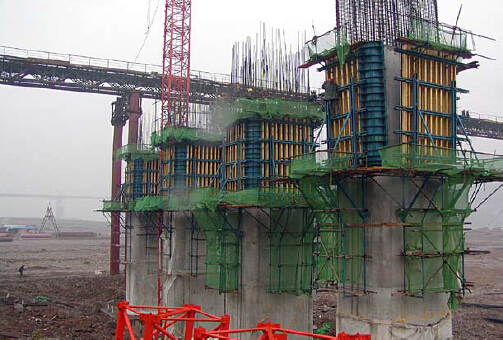
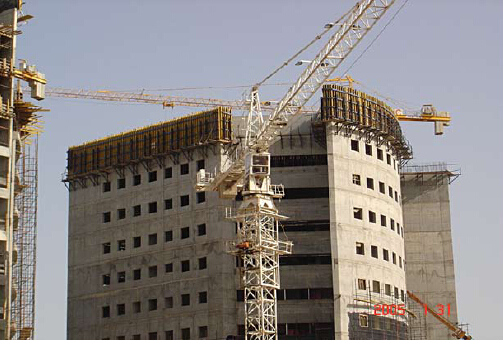
- Q: How is steel formwork constructed?
- Steel formwork is constructed by following a systematic process that involves several steps. The first step is to determine the dimensions and requirements of the concrete structure that needs to be formed. This includes taking into account the shape, size, and design of the structure. Once the dimensions are finalized, steel sheets are cut according to the required sizes and shapes. These sheets are then assembled and connected using different methods such as welding or bolting, depending on the design and strength requirements. The connections between the steel sheets are essential to ensure stability and rigidity of the formwork. After the assembly of the steel sheets, additional components such as stiffeners, braces, and beams are added to provide structural support and reinforcement to the formwork. These components help to distribute the load evenly and prevent any deformation during the pouring and curing of the concrete. Once the formwork structure is fully assembled and reinforced, it is placed in position and secured to the ground or existing structures using anchors or supports. This ensures that the formwork remains stable and in place during the concrete pouring process. The final step involves waterproofing the steel formwork to prevent any leakage or seepage of water from the concrete. This is typically done by applying a waterproofing membrane or coating to the inner surface of the formwork. Overall, the construction of steel formwork requires careful planning, precise cutting, accurate assembly, and proper reinforcement. It is crucial to follow industry standards and guidelines to ensure the structural integrity and safety of the formwork system.
- Q: Can steel formwork be used for both reinforced and unreinforced concrete structures?
- Yes, steel formwork can be used for both reinforced and unreinforced concrete structures. Steel formwork is a versatile and durable option that can be easily assembled and disassembled for various construction projects. It provides a strong and rigid framework for pouring concrete, ensuring that the concrete is held in place until it cures and gains sufficient strength. For reinforced concrete structures, steel formwork is especially beneficial as it can withstand the added weight and pressure of reinforcement bars and mesh. The steel formwork can be designed to accommodate the specific reinforcement requirements of the structure, allowing for the proper placement and alignment of the reinforcement elements. Similarly, steel formwork can also be used for unreinforced concrete structures. In this case, the formwork serves as a temporary mold that holds the concrete in the desired shape until it hardens. The steel formwork helps to achieve precise dimensions and finishes, ensuring that the final concrete structure meets the desired specifications. In summary, steel formwork is a suitable choice for both reinforced and unreinforced concrete structures. Its strength, durability, and flexibility make it a preferred option for various construction projects, providing a reliable and efficient solution for creating high-quality concrete structures.
- Q: How does steel formwork contribute to the overall strength and stability of a structure?
- Steel formwork contributes to the overall strength and stability of a structure by providing a rigid and durable framework that supports the weight of concrete during construction. It ensures accurate and precise shaping of concrete, preventing any deformations or cracks. The steel formwork also allows for faster construction as it can be reused multiple times, reducing costs and increasing efficiency. Additionally, its inherent strength and durability enhance the structural integrity of the building, making it more resistant to external forces and increasing its overall stability.
- Q: What are the different types of connections used in steel formwork systems?
- The different types of connections used in steel formwork systems include bolted connections, welded connections, and clamped connections. Bolted connections involve using bolts and nuts to secure the formwork components together. Welded connections involve fusing the steel components together using welding techniques. Clamped connections use clamps to hold the formwork components in place. These different types of connections provide varying levels of strength, stability, and ease of assembly and disassembly in steel formwork systems.
- Q: Is steel formwork suitable for projects with high wind loads?
- Yes, steel formwork is generally suitable for projects with high wind loads. Steel is a strong and durable material that can withstand the forces exerted by strong winds. It provides stability and structural integrity to the formwork system, ensuring the safety and stability of the construction project.
- Q: How does steel formwork affect the overall fire resistance of the structure?
- Steel formwork does not directly affect the overall fire resistance of the structure as it is typically temporary and removed after the concrete is set. However, steel formwork can indirectly contribute to the fire resistance by ensuring the concrete is properly poured and cured, which can enhance the overall fire resistance of the structure.
- Q: How does steel formwork affect the overall construction budget?
- The overall construction budget can be significantly affected by steel formwork. Although it may have a higher upfront cost compared to timber or plastic formwork, it offers various advantages that can result in long-term cost savings. One major advantage of steel formwork is its durability and reusability. It can withstand multiple uses without compromising its structural integrity, unlike timber or plastic formwork. This means it can be used for multiple construction projects, reducing the need for frequent replacements and lowering material costs over time. Furthermore, steel formwork is known for its high strength and stability, which allows for efficient concrete pouring and ensures precise dimensions. This reduces the risk of errors or reworks, which can cause significant time and cost overruns. Additionally, steel formwork typically requires less labor and time to assemble and dismantle compared to traditional materials. Its modular design and easy installation enable quicker construction progress, resulting in reduced labor costs and improved project efficiency. Moreover, steel formwork offers flexibility in design and customization, making it easy to build complex and intricate structures. This versatility eliminates the need for additional materials or specialized formwork systems, resulting in cost savings. In conclusion, despite its higher initial cost, steel formwork's durability, reusability, strength, and efficiency can lead to cost savings in terms of materials, labor, and time. By considering the long-term benefits and overall efficiency it provides, steel formwork can have a positive impact on the construction budget as a whole.
- Q: Can steel formwork be used for both interior and exterior concrete structures?
- Yes, steel formwork can be used for both interior and exterior concrete structures. Steel formwork provides durability, strength, and stability, making it suitable for various construction projects, regardless of the location or environment.
- Q: How does steel formwork affect the overall waterproofing of a building?
- Steel formwork does not directly affect the overall waterproofing of a building. The primary purpose of steel formwork is to provide structural support during the construction process. However, if not properly installed or sealed, it may create potential areas for water infiltration. Therefore, it is crucial to ensure proper waterproofing measures are in place, such as using waterproof membranes or coatings, to protect the building from water ingress.
- Q: How does steel formwork compare to plastic formwork in terms of cost and durability?
- Steel formwork generally tends to be more expensive than plastic formwork due to the higher cost of steel as a material. However, steel formwork offers better durability and longevity compared to plastic formwork. Steel can withstand heavy loads and repetitive use, making it more suitable for large-scale construction projects. While plastic formwork may be more cost-effective for smaller and temporary projects, steel formwork is a more cost-efficient and durable option for long-term use.
Send your message to us
Single-side climbing bracket for formwork and scaffolding systems
- Loading Port:
- Tianjin
- Payment Terms:
- TT OR LC
- Min Order Qty:
- 50 m²
- Supply Capability:
- 1000 m²/month
OKorder Service Pledge
OKorder Financial Service
Similar products
Hot products
Hot Searches
